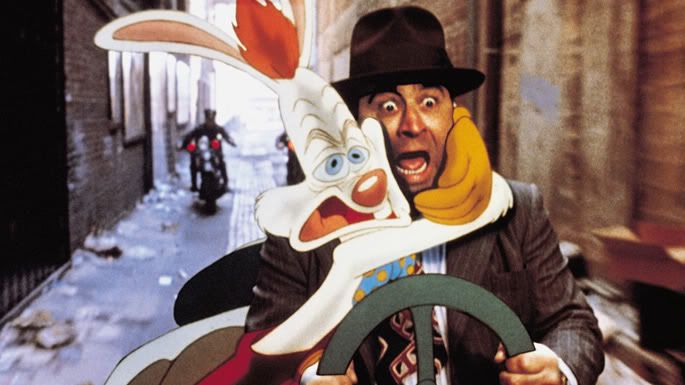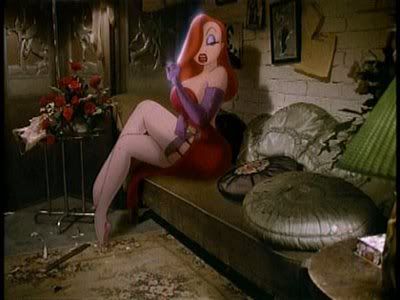 |
| Fig. 1 Who Frame Roger Rabbit poster. |

Robert Zemeckis' Who Framed Roger Rabbit is a wonderful example of how a hybrid of 3D footage and 2D animation can be completely successful.
 |
| Fig. 2 Roger and Valiant. |
Before discussing the impressive nature of this hybrid of animation and 3D sets it is the hybrid nature of the film's genre that runs along side these elements that will first be discussed. Roger Rabbit is a parody of the film noir genre. It contains much of the same visual language as the traditional noir film but it takes these conventions and subverts them into something much more comedic. Thomas M. Leitch believes that "The film repeatedly plays for laughs the conflicts between the mock-noir logic of its live-action world, from its moody lighting to its period costumes, and its cartoon world, jammed with puns, pratfalls, and cameos of Disney and Warners cartoon characters" (Leitch, 2002:270) What Leitch is expressing is that the film has taken the visual language of film noir, the atmospheric shadows that cast across characters and sets, and the 1940's private investigator's suit and fedora costume, and made fun of it by contrasting it with the bright and slapstick world of the drawn animation characters from the worlds of Disney and Warner Brothers. Another example of why the use of cartoon logic in the world of film noir is so interesting is, as Leitch discussed in Film Adaptation and Its Discontents, "The scene in which Jessica knocks out her husband deftly combines cartoon imagery...with the noir visual vocabulary appropriate to the film’s nominal genre and fictional setting (the atmospheric shadows cast over Roger’s face, darkening his overalls, and in the darkened alley by his unknown assailant). The result is a double visual matrix that produces not a coherent noir cartoon but a running series of comical quibbles on the inconsistencies between the worlds of noir and comics, as different in their ways as Los Angeles and Toon Town." (Leitch, 2007:211-2) This suggests that not only is this scene complex when it comes to animating, as to combine the traditional heavily shaded style of film noir with the usually bright and unshaded cartoon characters is a completely new experience, but that it creates a visual representation of the complete juxtaposition seen in the worlds of film noir and cartoons.
 |
| Fig. 3 Jessica Rabbit. |
From the subversion of noir conventions to the ingenious use of live-action actors interacting with the cartoon characters around them A great example of this is, as Leitch explains. "when Jessica ...tells private eye Eddie Valiant...“I’m not bad. I’m just drawn that way.” The implication is not only that cartoon logic can be adapted to live-action situations, but that live-action logic itself is less monolithic, more multifarious, and in its different versions more parochial and generic and subject to transformation than it might appear." (Leitch, 2002:270) This suggests that the previous idea of the live-action being very structured and mostly generic in what can be done with it has been completely subverted by this hybrid style of filming. By adding the cartoon characters that interact with the sets and actors, combined with using the sets and camera movements in the typical live-action way, Zemeckis has unlocked a completely new way of creating live-action footage and its use of space. J.P. Telotte divulges that "They wanted to determine whether it would be possible to make the combination of live action and animation more believable than in any earlier hybrid films. Significantly, they determined that the key to combining these elements successfully would be the film’s spatial experience, particularly the possibilities for creating convincing character interaction across the different sorts of spaces the characters would occupy and effectively using camera movement to join those spaces, to suture the live and animated worlds as seamlessly as possible." (Telotte, 2010:184) Telotte is explaining that to create these animated spaces was incredibly important to the creation of this film. Not only did it have to feel like a live-action film but the cartoon characters had to fit in as well as all the humans. To do this they had to concentrate on the kinds of spaces the characters would need to occupy and the effect on the people around them it would have. Clearly all this planning worked extremely well as the animation and actor interaction is almost seamless.
Who Framed Roger Rabbit is fantastically entertaining as it blends its toon-like slapstick with the film noir threat of physical violence. Telotte went on to construe that "Zemeckis has created a pointedly stylized, nostalgic, noirish world, that of Los Angeles in 1947...it is a world that has already sorted out for itself this other stylized realm, specifically the curious breach of reality that the mingling of humans and Toons represents, which is always one of the astonishments of every hybrid narrative." (Telotte, 2010:187) This is very true indeed. The film is a whole, everything has been thought about carefully and planned to perfect authenticity. From the effect that noir-style lighting would have on the cartoon characters to the interaction they would have with physical objects. This hybrid narrative is as astonishing as it is entertaining and its perfect balance of Disney and Warner Brothers characters will probably never be repeated.
List of Illustrations
Figure 1. Who Framed Roger Rabbit (1988) Who Framed Roger Rabbit poster. At: http://www.movieposterdb.com/poster/c3357056 (Accessed on 04.12.11)
Figure 2. Who Framed Roger Rabbit (1988) Roger Rabbit and Valiant. At: http://whatculture.com/wp-content/uploads/2009/11/who_framed_roger_rabbit_1987_685x385.jpg (Accessed on 04.12.11)
Figure 3. Who Framed Roger Rabbit (1988) Jessica Rabbit. At: https://blogger.googleusercontent.com/img/b/R29vZ2xl/AVvXsEhd-IWSbJp5CiypwmMhQMPtM01aK-Mq0yI70WHFOtrN7dvR5ZD0YY3zQhI75Kcu22xXlUnpTD5GU_LOt10Nsj-h5ZZNx3CEWgtCcqgXNRpHMwGuisKzlQwB5UGHzFQ_iggluYv_xEukpJD-/s400/Roger-Rabbit-2-web.jpg (Accessed on 04.12.11)
Bibliography
Leitch, Thomas M. (2002) Crime Movies. USA: Cambridge University Press.
Leitch, Thomas M. (2007) Film Adaptation and Its Discontents : From Gone with the Wind to the Passion of the Christ. USA: Johns Hopkins University Press.
Telotte, J.P. (2010) Animating Space : From Mickey to WALL-E. USA: University Press of Kentucky

No comments:
Post a Comment